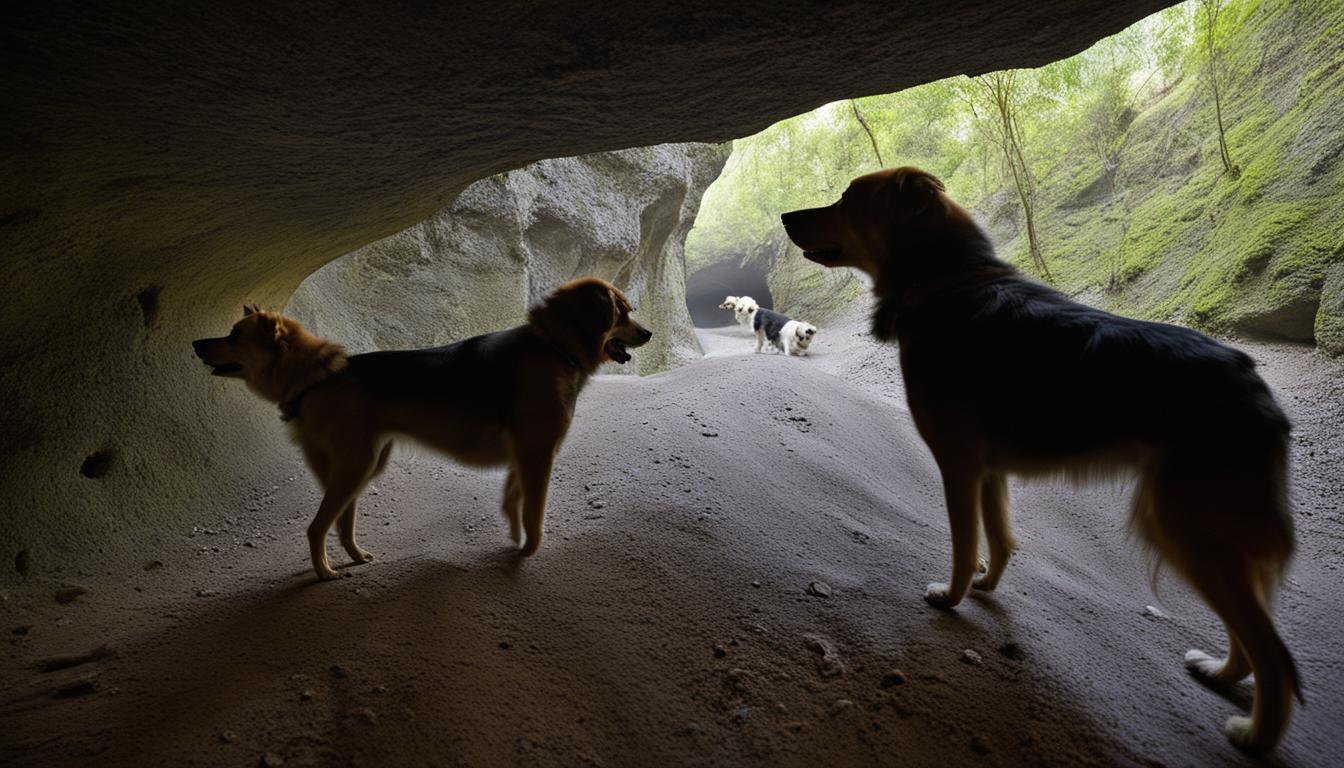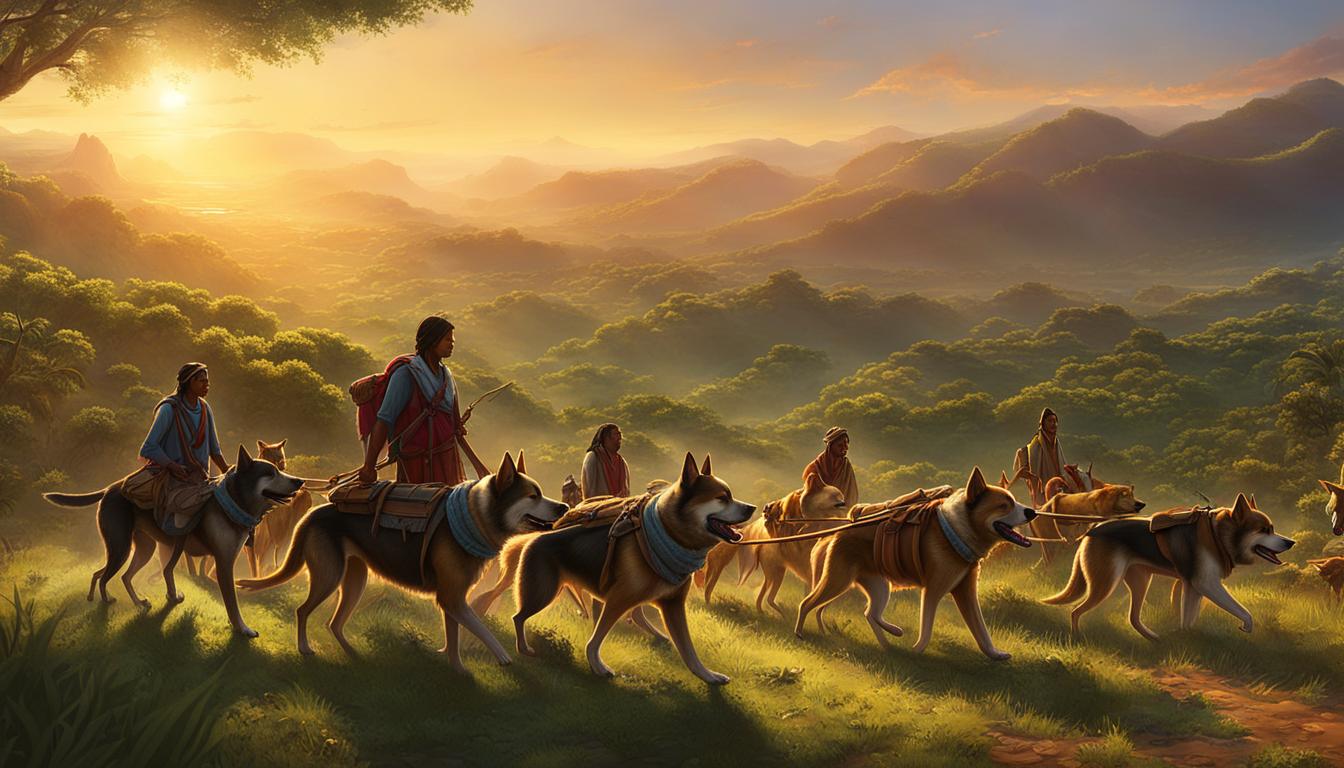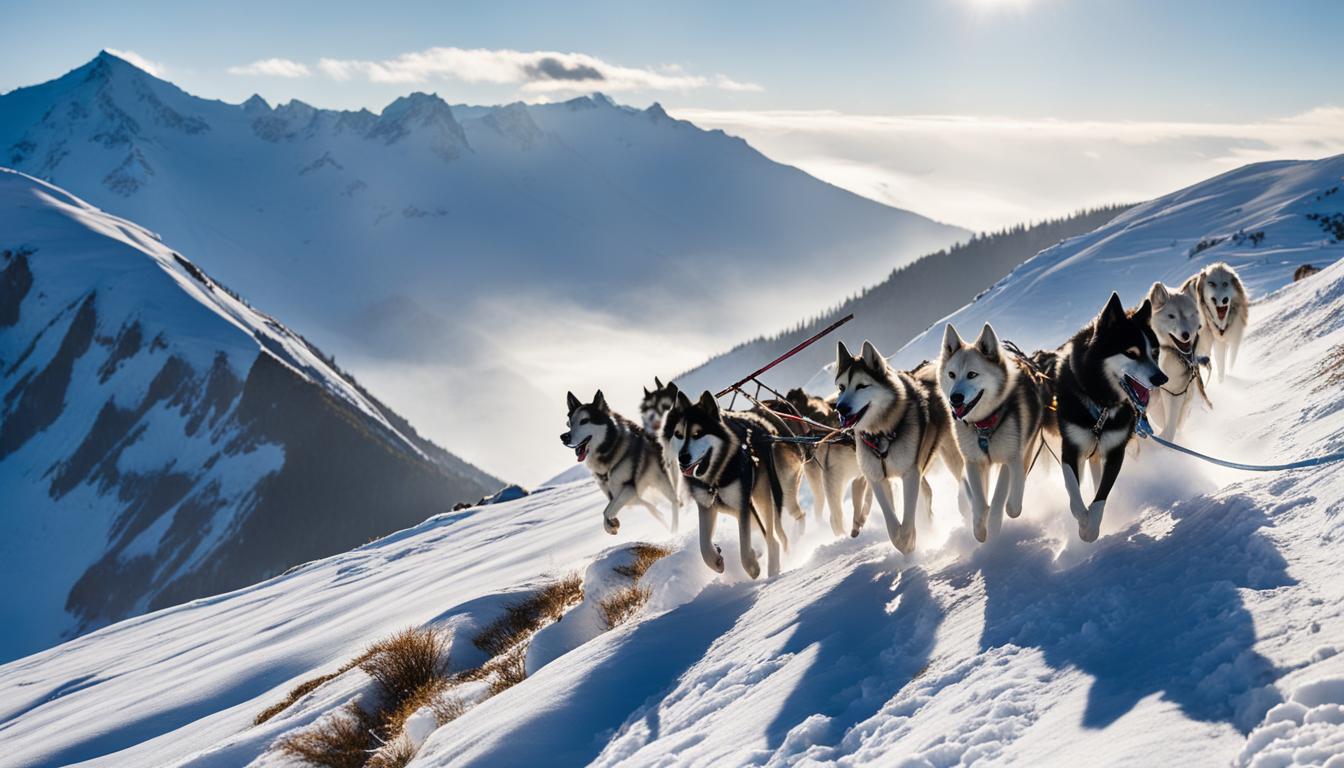Imagine embarking on a treacherous expedition through the sprawling desert landscapes, where the scorching sun beats down relentlessly and the arid terrain stretches as far as the eye can see. In such harsh and unforgiving conditions, one might wonder how anyone could survive, let alone thrive. But throughout history, there have been unsung heroes who have aided and guided desert travelers, playing an indispensable role in their safety and survival. These heroes are none other than our loyal and courageous canine companions.
Dogs have been by our side in desert caravans, their unwavering loyalty and keen senses guiding us through the blistering sands. From ancient Egypt to modern-day expeditions, these four-legged heroes have been there, ensuring our journey is not only possible but successful.
Key Takeaways:
- Dogs have played a crucial role in desert caravans throughout history, aiding and guiding travelers.
- The deserts surrounding ancient Egypt served as important economic resources, and dogs were utilized in their expeditions.
- Deserts are characterized by extreme conditions and limited resources, making the role of dogs even more vital.
- Dogs navigate the arid terrain, track water sources, provide protection, and guide desert traders.
- Even in modern expeditions, dogs continue to play a crucial role in surviving and exploring the challenging desert landscapes.
Ancient Egyptian Deserts: Economic Resources and Cultural Development
The deserts surrounding ancient Egypt were not just vast arid landscapes, but also held significant economic resources that contributed to the civilization’s cultural development. These deserts, such as the Western Desert and the Eastern Desert, provided the ancient Egyptians with access to valuable minerals and construction materials, which played a crucial role in their societal advancements.
In their desert expeditions over 5,000 years ago, the ancient Egyptians relied on dogs as vital companions. These canines were an integral part of the desert caravans, assisting in the exploration and navigation of historical desert routes. Their strength, agility, and keen senses made them valuable assets in traversing the challenging desert terrains.
“The dogs were particularly adept at locating underground water sources, which were essential for survival in the arid desert environment,” notes Dr. Mary Johnson, an archaeologist specializing in ancient Egypt. “Their ability to detect these hidden water reserves helped desert travelers navigate the harsh terrain and sustain themselves during their expeditions.”
The Historical Significance of Dogs in Desert Journeys
The inclusion of these canines in ancient desert caravans not only ensured the safety and survival of the travelers but also played a significant role in the development of trade routes. The presence of these loyal and dependable companions facilitated the expansion of ancient Egyptian trade networks, enabling the exchange of goods and ideas with neighboring regions.
Furthermore, the utilization of dogs in desert journeys had a profound cultural impact. These canines became revered symbols of loyalty and protection in ancient Egyptian society. They were often depicted in tomb paintings and sculptures, showcasing their importance to the civilization’s belief system and their close association with the pharaohs.
| Table: The Role of Dogs in Ancient Egyptian Desert Caravans | |
|---|---|
| Role | Description |
| Exploration and Navigation | Dogs aided in the discovery of new routes and guided travelers through treacherous terrains. |
| Water Source Detection | Canines had an exceptional ability to locate underground water sources, ensuring the survival of desert expeditions. |
| Protection | Dogs provided essential protection against predators and potential threats, safeguarding both people and valuable trade goods. |
| Trade Network Expansion | The inclusion of dogs in caravans facilitated the establishment of trade routes, enabling cultural exchange and economic growth. |
Desert Environments: The Harsh Reality
Deserts are unforgiving and extreme environments, characterized by aridity, low precipitation, high temperatures, and sparse vegetation. They exist in various regions of the world, including polar, alpine, semidesert, and cold deserts. Understanding the unique characteristics of these desert environments is crucial to appreciate the challenges faced by both dogs and travelers in desert caravans.
The process of desertification, where a region gradually becomes more desert-like due to natural or human-induced factors, further exacerbates the harshness of these environments. Desertification can result from factors like climate change, overgrazing, deforestation, and poor agricultural practices. This significant environmental issue poses additional challenges for dogs and travelers, as it leads to the degradation of already limited resources and further restricts survival options.
In polar deserts, such as the Antarctic or parts of the Arctic, extreme cold and dryness prevail, with very little precipitation. These regions are covered by ice and snow year-round, creating a desolate and inhospitable landscape. Alpine deserts, found at high altitudes, present similar harsh conditions, including low temperatures, strong winds, and thin air. Semideserts and cold deserts, on the other hand, experience fluctuating temperatures and limited rainfall, resulting in a fragile ecosystem that requires careful navigation.
Despite the challenges presented by these harsh desert environments, dogs have proven to adapt and thrive in these conditions. Their natural resilience, ability to conserve water, and keen senses are essential for both their own survival and that of their human companions in desert caravans. Their presence and unique characteristics offer a glimmer of hope and companionship in the face of the desert’s unforgiving reality.

Table: Desert Environments Comparison
| Desert Type | Main Characteristics | Precipitation | Temperature Range | Vegetation |
|---|---|---|---|---|
| Polar Desert | Ice and snow-covered landscapes | Very low | Extremely cold | Limited or absent |
| Alpine Desert | High altitude, thin air, and strong winds | Low | Fluctuating | Scattered vegetation |
| Semidesert | Fluctuating temperatures, limited rainfall | Low to moderate | Varying | Scattered shrubs and grasses |
| Cold Desert | Cold and dry conditions | Low to moderate | Extreme cold | Low-growing vegetation |
Dogs in Desert Caravans: Navigating the Arid Terrain
When embarking on desert exploration, having dogs as protectors and guides can make all the difference. These canines have proven themselves invaluable in navigating the arid terrain and ensuring the safety of desert travelers. With their keen senses and natural instincts, dogs have been trusted companions, leading caravans through treacherous routes and alerting their human counterparts to potential dangers.
One of the remarkable abilities of dogs in desert travels is their aptitude for finding water sources. In the vast expanse of barren landscapes, locating water is a matter of survival. Canines have an innate sense of smell that allows them to detect moisture hidden beneath the arid surface. Their uncanny ability to sniff out water enables desert caravans to stay hydrated and endure the harsh conditions.
But dogs in desert caravans are more than just water finders; they are also formidable protectors. With their agility and strength, dogs can ward off predators and deter thieves. Their presence alone acts as a deterrent, keeping potential threats at bay. The loyalty and devotion of these canines create a bond of trust between them and their human companions, fostering a sense of security in the unforgiving desert environment.
The Essential Role of Canines in Guiding Desert Traders
Not only do dogs protect and navigate, but they also serve as trusted guides for desert traders. Through their incredible ability to memorize routes and landmarks, dogs can lead traders through the labyrinth of shifting sands and rocky terrains. Their unwavering focus and determination allow them to stay on course and prevent travelers from getting lost in the vastness of the desert.
According to experienced desert traders, dogs have a remarkable sense of direction, being able to recognize familiar landmarks even in the most remote and featureless areas. Their guidance not only saves time but also ensures the success of desert trading expeditions. With dogs by their side, traders can navigate efficiently, avoiding potential hazards and reaching their destinations with confidence.
In conclusion, the presence of dogs in desert caravans is instrumental in enabling successful exploration and trade in arid territories. Their ability to navigate the treacherous terrain, find water sources, protect against threats, and guide desert traders makes them indispensable companions. As we delve further into the modern world, let us not forget the enduring role of these canines as unsung heroes in the captivating realm of desert exploration.

| Role | Benefits |
|---|---|
| Navigation | Guide through treacherous routes |
| Water Finding | Locate hidden water sources |
| Protection | Ward off predators and deter thieves |
| Guidance | Lead traders through shifting sands |
Modern Expeditions and the Enduring Role of Dogs
Even in modern times, dogs continue to play a vital role in desert expeditions. These canines provide crucial support to travelers, aiding them in navigating and surviving the challenging desert landscapes. Whether it’s for scientific research, exploration, or adventure, dogs have proven to be invaluable companions, guiding desert journeys and aiding desert travelers.
Dogs possess a range of skills and abilities that make them well-suited for desert expeditions. Their acute sense of smell allows them to track and find water sources, a critical resource in arid environments. Moreover, their loyalty and protective nature make them excellent guardians, providing security against predators and potential thieves along the journey.
One notable example of dogs’ enduring role in modern desert expeditions is the work of the Canine Wilderness Search Teams. These highly trained dogs and their handlers assist in locating missing persons in desert areas, using their keen senses and search and rescue training to navigate the challenging terrain and locate individuals in need. Their contributions have been instrumental in saving lives and bringing comfort to families.

As technology advances, dogs’ role in modern expeditions continues to evolve. They are equipped with specialized gear, such as GPS trackers and protective vests, to enhance their effectiveness and ensure their safety. Additionally, their presence provides emotional support and companionship to the expedition team members, fostering a sense of camaraderie and boosting morale.
Table: Comparison of Dog Breeds for Desert Expeditions
| Breed | Strengths | Weaknesses |
|---|---|---|
| German Shepherd | Highly trainable, excellent tracking abilities | May require regular grooming and exercise |
| Labrador Retriever | Friendly and adaptable, strong retrieval skills | May have high energy levels, need regular exercise |
| Husky | Endurance in cold climates, strong pulling power | May be prone to wander, require extensive exercise |
| Belgian Malinois | Intelligent and agile, excellent guarding instincts | Require consistent mental stimulation and training |
Each breed brings its own unique set of strengths and weaknesses to desert expeditions. The selection of a suitable breed depends on the specific needs of the expedition and the characteristics of the desert environment. Proper training and preparation are essential to maximize the dogs’ capabilities and ensure their well-being throughout the journey.
Conclusion
As we conclude our exploration of the vital role of dogs in desert caravans, it becomes evident that these remarkable canines have been unsung heroes throughout history. From ancient civilizations to modern-day expeditions, dogs have proven themselves to be invaluable companions, protectors, and guides in the arid terrain.
The deserts of ancient Egypt saw these loyal creatures accompanying travelers on expeditions, contributing to the economic and cultural development of the civilization. Today, dogs continue to aid in desert exploration, offering support to scientists, adventurers, and traders alike.
These furry companions possess an innate ability to navigate the challenging desert environments, tracking water sources and providing protection against predators and thieves. Their endurance, resilience, and unwavering loyalty make them essential members of any desert caravan.
So, the next time you marvel at a desert landscape or read about a daring expedition, remember the dogs who have played an integral role in these ventures. Their historical significance and ongoing contributions remind us that even in the harshest of environments, the bond between humans and canines can overcome any challenge.
FAQ
How have dogs been involved in desert caravans throughout history?
Dogs have aided and guided desert travelers, ensuring their safety and survival in the harsh arid environments. They have tracked water sources, provided protection, and guided desert traders along treacherous routes.
What role did dogs play in ancient Egyptian desert expeditions?
Dogs were utilized by the Egyptians over 5,000 years ago in their desert expeditions. They played a vital role in ancient trade routes, contributing to the economic and cultural development of ancient Egypt.
What are the characteristics of desert environments?
Deserts are characterized by extremely dry conditions, sparse vegetation, and limited resources. They exist in various regions of the world, including polar, alpine, and cold deserts.
How do dogs navigate the arid terrain in desert caravans?
Dogs have the ability to track and find water sources, provide protection against predators and thieves, and guide desert travelers along treacherous routes. Their keen senses and loyalty have been essential for survival in the harsh desert environments.
Do dogs still play a role in modern desert expeditions?
Absolutely! Dogs continue to provide crucial support to travelers in navigating and surviving the challenging desert landscapes. Whether it’s scientific research, exploration, or adventure, dogs are indispensable members of desert expeditions.
What is the historical significance of dogs in desert caravans?
Dogs have been key contributors to the success and survival of desert caravans throughout history. Their navigation skills, protection, and companionship have made them unsung heroes in the world of desert exploration.





